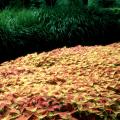Southern Gardening from 2003
By Norman Winter
MSU Horticulturist
Central Mississippi Research & Extension Center
The Becky variety of shasta daisies has been chosen as the Perennial Plant of the Year for 2003. Every Mississippi landscape needs this showy flower, which is probably the best shasta daisy for the South. While all others tend to melt a bit in the torrid heat and humidity, this lady keeps her composure.
By Norman Winter
MSU Horticulturist
Central Mississippi Research & Extension Center
Most of us can hardly wait until the first blooms announce that spring is just around the corner. Over the holidays, I saw a flowering quince with several coral-colored blossoms already open, but you need a Taiwan flowering cherry if you really want to herald the approaching spring.
By Norman Winter
MSU Horticulturist
Central Mississippi Research & Extension Center
Farmers want to get rid of them and landscapers want to plant them, but two native hollies are at the top of my list of best shrubs or small trees we can grow in Mississippi.
Yaupon hollies are native throughout the Southeast. They are great shrubs for sunny beds and yet look good in shade. They tolerate clays, sand and everything in between.
By Norman Winter
MSU Horticulturist
Central Mississippi Research & Extension Center
The winter already seems long, and if you are like me, we're ready to dig in the dirt. These next weeks before Spring offer great opportunities to plan for our beds to be the showiest ever. One plant you should consider is a new Rudbeckia hirta, or black-eyed susan, known as Prairie Sun.
By Norman Winter
MSU Horticulturist
Central Mississippi Research & Extension Center
In today's container, basket or window-box plantings, cascading plants have become the ideal finishing touch for the overall design scheme.
In recent years, I have urged gardeners to choose plants that gently cascade over the rim. While that is still important, the new look includes those that reach the container's edge, then plummet toward the ground.
By Norman Winter
MSU Horticulturist
Central Mississippi Research & Extension Center
Late winter cold snaps are enough to make a gardener want to have a groundhog killing, but it would be better to channel our frustrations toward planning this year's landscapes. Therefore, I want to call your attention to a new, must-have plant for 2003.
By Norman Winter
MSU Horticulturist
Central Mississippi Research & Extension Center
I predict Amber Waves, a new heuchera, will be one of the most sought-after plants this spring.
When I saw Amber Waves in trials last year, I figured it would take a couple of years to get to our state, but I just saw it at a Mississippi greenhouse complex. Our gardeners are fortunate to have such progressive growers as those in the Mississippi Nursery and Landscape Association.
By Norman Winter
MSU Horticulturist
Central Mississippi Research & Extension Center
Superbena is sure to be hot this year, so get ready to look for this new verbena at a local garden center while supplies last.
Superbena certainly does look to be super and even monolithic in size by verbena standards, but gee, how about a better name? Obviously Proven Winners knows how to produce good plants and make a fortune without me, so I'll stop whining.
By Norman Winter
MSU Horticulturist
Central Mississippi Research & Extension Center
Since gardening season is almost here, I feel compelled to remind you of a wonderful and honored plant that you might not have tried: the perennial phlox known as David.
By Norman Winter
MSU Horticulturist
Central Mississippi Research & Extension Center
The past few years have given me a new appreciation for the various iris species available to Southern gardeners. With careful selection, we can enjoy a long season of iris blooms.
Everyone ought to consider the Japanese iris, known botanically as Iris ensata. It complements the Louisiana and Siberian irises with toughness, beauty and blooms that are born in glorious summer displays after the other irises have finished. They flourish from zones 4 to 9.
By Norman Winter
MSU Horticulturist
Central Mississippi Research & Extension Center
At one of the entrances to Northpark Mall in Jackson, a recently planted flower bed reveals wonders about a plant most people take for granted. The bed contains a fairly new variety of ajuga called Mahogany, which is known for its dark purple leaves and bright blue flowers.
Ajuga is quite versatile: In this bed, it was planted in combination with Butterfly Blue scabiosa, a recent perennial plant of the year, making for a very showy display.
By Norman Winter
MSU Horticulturist
Central Mississippi Research & Extension Center
Autumn Blaze maple and Edward Goucher abelia are two outstanding performers chosen as 2003 Mississippi Medallion winners by the state Plant Selections Committee.
If you want a large, fast-growing tree with spectacular fall color, choose the Autumn Blaze maple. A hybrid of the native red maple and the silver maple, Autumn Blaze combines the best features of both. It has the vigor of the silver maple and the beauty, strength and heat tolerance of the red maple.
By Norman Winter
MSU Horticulturist
Central Mississippi Research & Extension Center
Costa Rica Blue salvia and Sonset lantana are two outstanding performers chosen as 2003 Mississippi Medallion winners by the state Plant Selections Committee. They may be classified as hummingbird champions.
By Norman Winter
MSU Horticulturist
Central Mississippi Research & Extension Center
Sitting at your local garden center just waiting for adoption is one of the most easily grown perennials, the Early Sunrise coreopsis. Known botanically as Coreopsis grandiflora, it is native to North America and offers brilliant golden-yellow flowers borne on 2-foot-long stems all summer. If that isn't enough, the Early Sunrise will return to your garden next year.
By Norman Winter
MSU Horticulturist
Central Mississippi Research & Extension Center
Americans have been showing their colors a lot since the terrorist attacks of Sept. 11, 2001, and the current conflict is motivating even more. Flowers can be part of the waving of the red, white and blue.
By Norman Winter
MSU Horticulturist
Central Mississippi Research & Extension Center
If you are one who enjoys taking in the sights and smells of a Southern garden after-hours, consider one of the most spectacular vines available, the moonflower.
The moonflower is related to the morning glory and originates from tropical America. It is the kind of plant that makes memories for your children. It is an heirloom, or antique, vine grown in the South that all children, and adults for that matter, need to experience.
By Norman Winter
MSU Horticulturist
Central Mississippi Research & Extension Center
If I had to list the best flower introductions of the last 10 years, I might have to put angelonias at the top. It seems like it was only yesterday when I saw my first ones in the median of downtown Raymond. Then there was the introduction of Hilo Princess, a Florida Plant of the Year, and a few obscure varieties.
By Norman Winter
MSU Horticulturist
Central Mississippi Research & Extension Center
Visitors fell in love with a previously loathed plant in a shade garden on the Gardens of Madison County tour.
While some gardeners think of oxalis as a tough plant to kill or eradicate, they also should consider the beauty of the purple oxalis. Purple oxalis has large, triangular leaves of deep purple. Its nearly 1-inch flowers range in color from pink to lilac.
By Norman Winter
MSU Horticulturist
Central Mississippi Research & Extension Center
Who knows why I remember the Brylcream slogan, "A little dab'll do ya," or what the connection is in my mind to coleus? I'm thinking that a little dab of coleus may do, but the bigger the dab, the better.
By Norman Winter
MSU Horticulturist
Central Mississippi Research & Extension Center
At a garden center recently, I saw one of the best buys in flowers just waiting for a good home. This plant was offered in feathery plumes, cockscombs or flowers resembling wheatears. You guessed it -- it was the celosia.
Originating in the tropics, the celosia produces flowers from summer through fall. Its ability to withstand drought and extremely hot temperatures should win it a Mississippi Medallion Award, a Georgia Gold Medal and every other honor in the South.




















